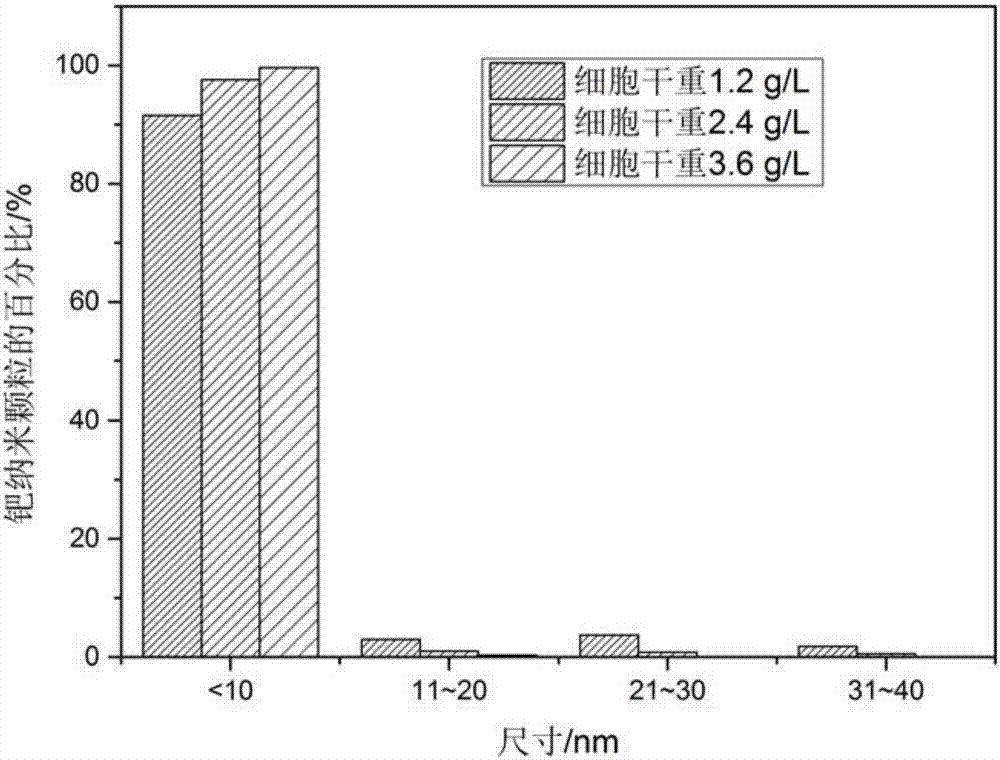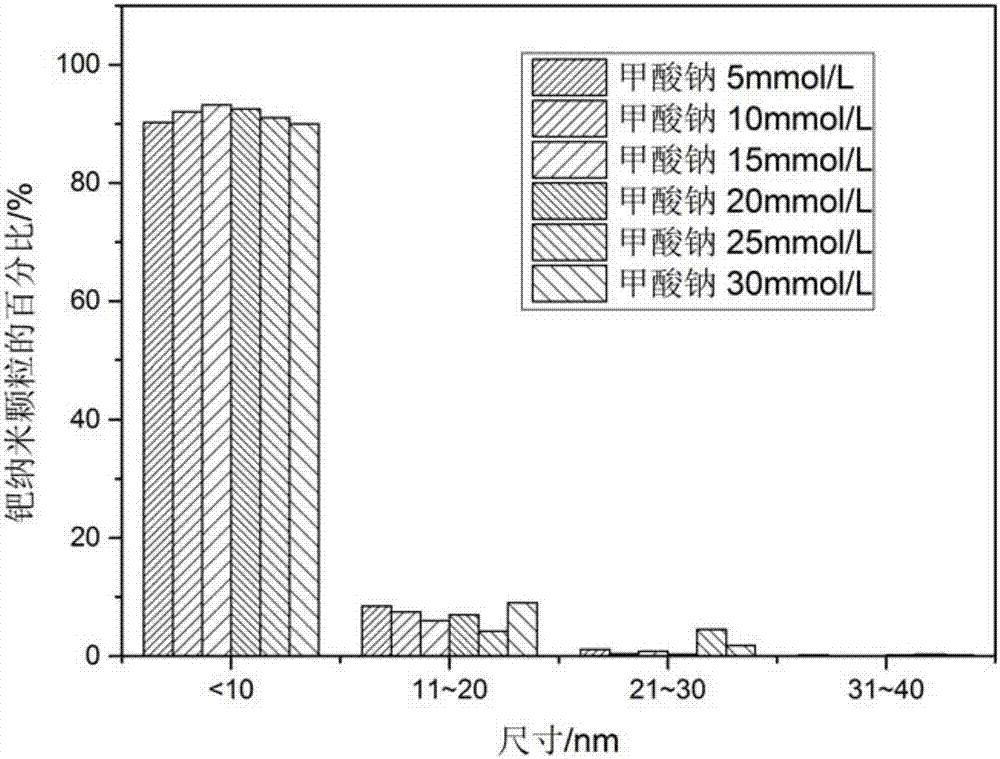Biological palladium catalyst and preparation method and application thereof
A palladium catalyst and biological technology, which is applied in the field of environmental microbial materials and pollutant degradation, can solve the problems of uneven particle size, small specific surface area, and high requirements for instruments and equipment, and achieve good catalytic performance, good chemical stability, and preparation method simple effect
- Summary
- Abstract
- Description
- Claims
- Application Information
AI Technical Summary
Problems solved by technology
Method used
Image
Examples
Embodiment 1
[0034] After culturing Enterococcus faecalis in LB medium for 2-3 days, collect them by centrifugation (at 20°C, at 8000 rpm for 5 min), wash them with deionized water for 3 times, and then use deionized water to make a bacterial suspension (1.2-3.6 g·L -1 ); take 10 mL of bacterial suspension into the volumetric flask, add sodium tetrachloropalladate solution, adjust the pH to 3, add electron donor sodium formate solution, and set the volume to 50 mL, so that the final concentration of sodium tetrachloropalladate is 50 mg L -1 ~250mg·L -1 , the electron donor concentration is 5~30mmol·L -1 ; Put it into a constant temperature oscillator at 20-60°C for 48 hours and then centrifuge (at 25°C, centrifuge at 8000rpm for 6min) to collect, and wash with deionized water for 2-4 times; after ultrasonic crushing for 30min, centrifuge (at 25°C, Centrifuge at 8000 rpm for 6 min), wash 3 times, and dry at 60° C. for 6 hours to obtain nano-palladium.
[0035] Investigate the relationshi...
Embodiment 2
[0044] Take 10mL of 1.2g·L -1 Enterococcus faecalis bacterial suspension is placed in the volumetric flask, adds sodium tetrachloropalladate solution, adjusts pH to be 3, adds electron donor sodium formate solution, is settled to 50mL, makes the concentration of final sodium tetrachloropalladate be 210mg. L -1 , the concentration of sodium formate is 25mmol L -1 ; put it in a constant temperature oscillator at 40°C for 48 hours, collect it by centrifugation, wash it with deionized water for 2-4 times, and ultrasonically break it for 30 minutes (add deionized water to 20-30mL of Palladium-containing Enterococcus faecalis after cleaning, and use ultrasonic power 120W, the ultrasonic working time is 5s, and the interval time is 5s), centrifuged and washed 3 to 5 times, and dried at 50°C for 10 hours to obtain nano-palladium. The TEM figure (transmission electron microscope) of the nano-palladium (nano-palladium prepared by biological method) prepared by the present embodiment i...
Embodiment 3
[0048] Select a 100mL centrifuge tube as the reaction vessel, weigh 0.1000g of the catalyst prepared in Example 2 (nano palladium prepared by a biological method, i.e. bio-palladium) and add it to 50mL of 5mg / L 2,3,4'-trichlorobiphenyl solution, adjust the pH to be neutral, put it into an ultrasonic scrubber (180W) and dissolve for 2min; add sodium formate (10-30mmol L -1 ) as an electron donor, and finally reacted at room temperature in a constant temperature oscillator. In the control group, no catalyst was added, and three parallel experiments were performed in each group. The samples were filtered through a 0.5 μm needle filter and then extracted by 5 mL for gas chromatography and ion chromatography. The curve graph of the concentration of 2,3,4'-trichlorobiphenyl in the reaction solution changing with the catalytic time is as follows Figure 7 As shown, it can be found that 2,3,4'-trichlorobiphenyl can be completely removed after 48h. The curve graph of the amount (conc...
PUM
 Login to View More
Login to View More Abstract
Description
Claims
Application Information
 Login to View More
Login to View More - R&D
- Intellectual Property
- Life Sciences
- Materials
- Tech Scout
- Unparalleled Data Quality
- Higher Quality Content
- 60% Fewer Hallucinations
Browse by: Latest US Patents, China's latest patents, Technical Efficacy Thesaurus, Application Domain, Technology Topic, Popular Technical Reports.
© 2025 PatSnap. All rights reserved.Legal|Privacy policy|Modern Slavery Act Transparency Statement|Sitemap|About US| Contact US: help@patsnap.com



